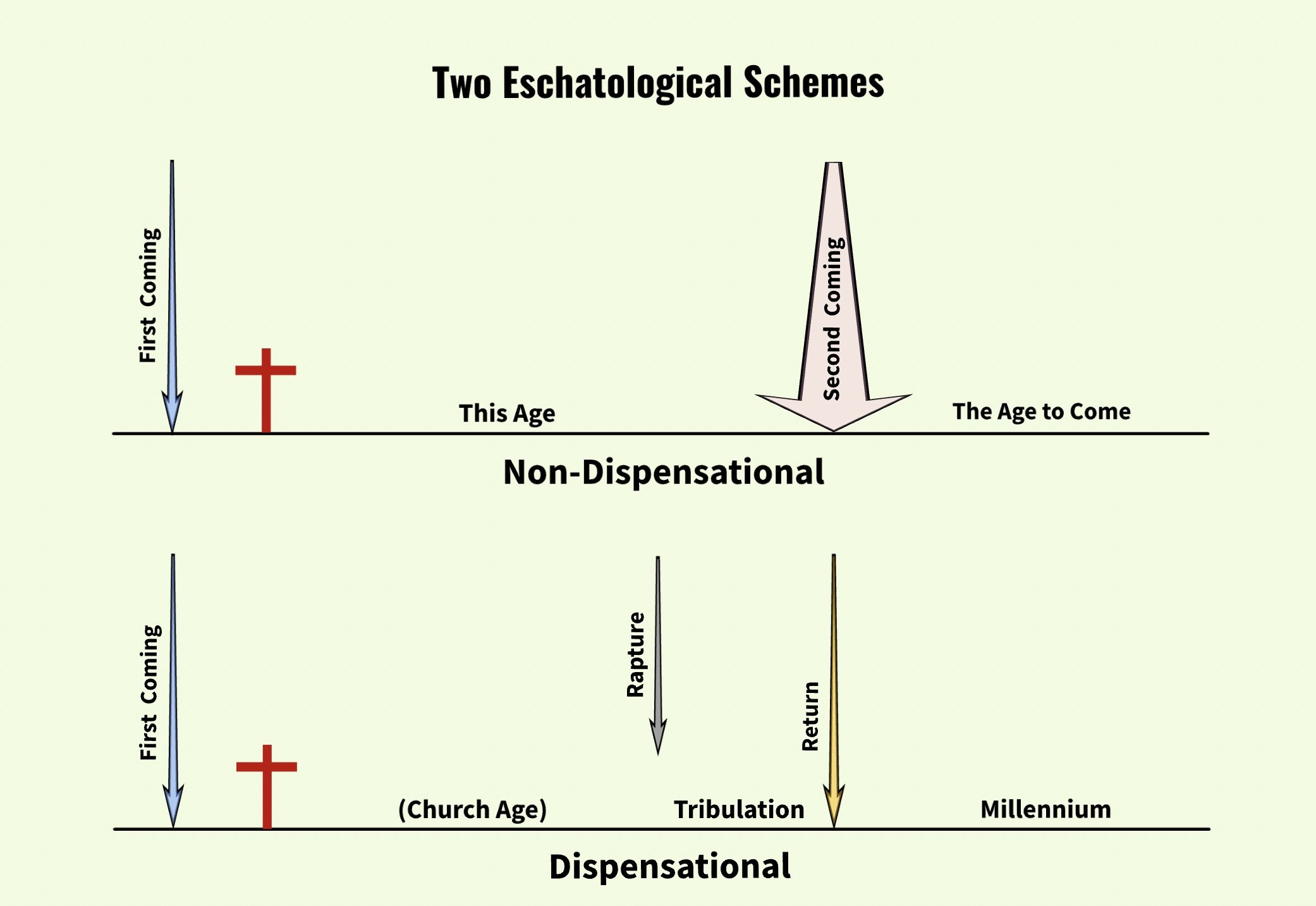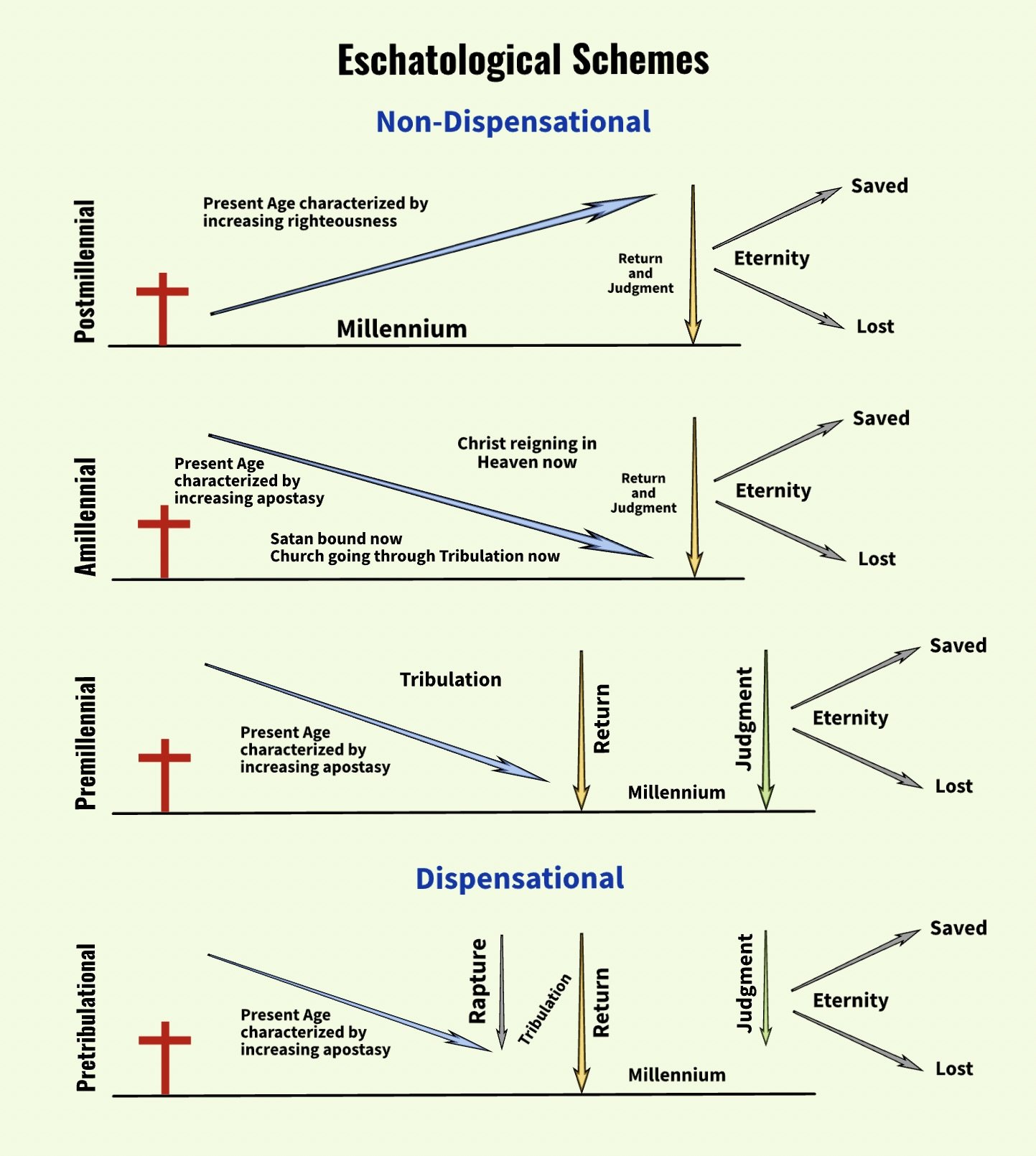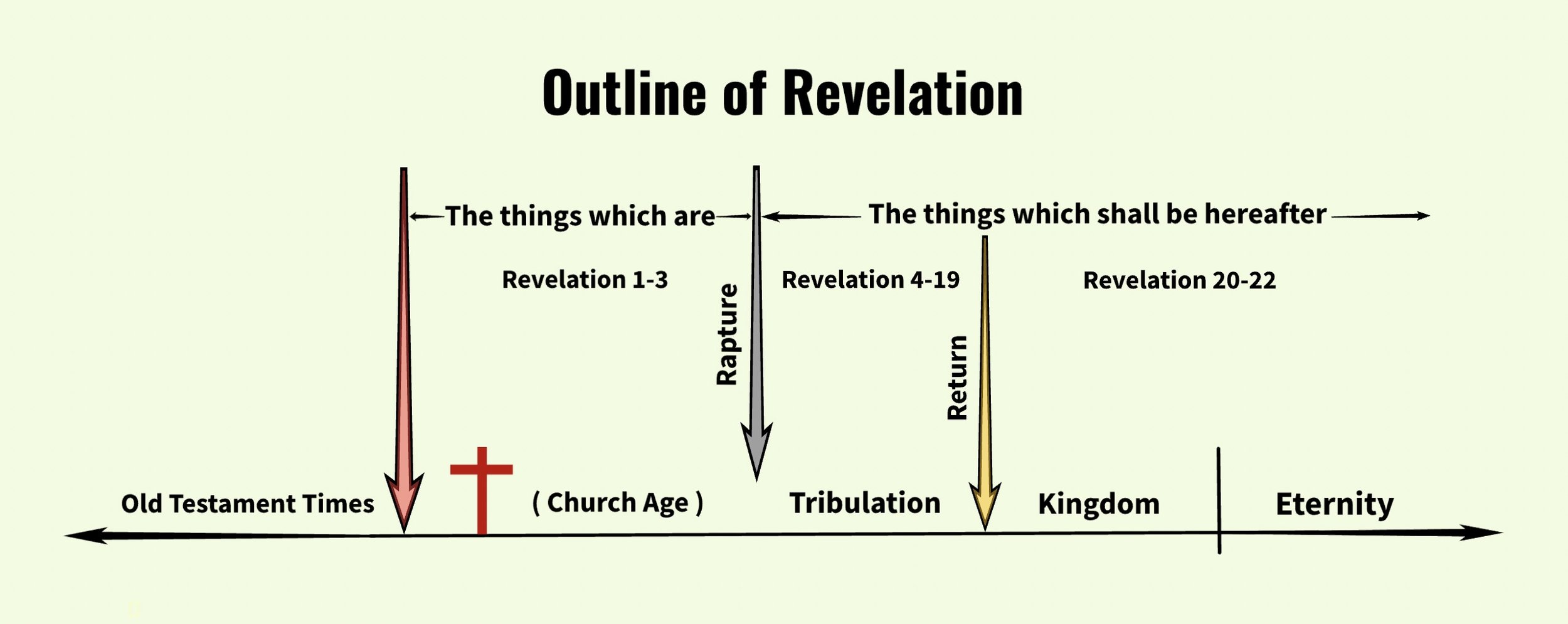Principle 20
HERMENEUTICS
PRINCIPLE 20
Distinguish Between the Rapture and the Return
How often do you wonder about what will happen the future? The Bible has a lot to say about future times and events, but Christians have differing views on the interpretation of these Scriptures. One of the major questions is the second coming of Christ. All Christians believe that Jesus will return to this earth as He promised, but they differ about the details. In this principle, we’ll look at different systems of end time events and see how they affect our interpretation.
Eschatology is the doctrine of “last things,” or the study of future events. This illustration shows two different eschatological schemes:
Some Christians believe that all of the end-time events will occur at the same time, as shown in the first diagram, labeled “Non-Dispensational.” In this view, we live in “This Age.” All the end-time events described in the Bible, including the second coming of Christ and the final judgments, will occur at the transition between “This Age” and “The Age to Come.” Dispensationalists, however, believe that this scheme is too simplified.
The non-dispensational eschatological system is portrayed in the “Amillennial” diagram. Amillennial means “no millennium,” that is, no 1,000-year reign of Christ on this earth. Amillennialists believe the millennium described in Revelation 20, during which Satan is bound for 1,000 years, is taking place now (during “this age”). When questioned about satanic activity in this age, amillennialists try to rationalize it by essentially saying that “Satan is bound, but he’s bound on a very long chain”!
As you can see in this illustration, there are a few other non-dispensational eschatological diagrams. The Premillennial position recognizes a literal 1,000 reign of Christ. The Amillenial and Premillennial positions do not recognize the rapture of the church. Only the Dispensational view distinguishes between the rapture of the church and the return of Christ.
In the Dispensational system (bottom diagram), the “rapture” is the return of Christ to the air, to receive His bride, the Church. The word rapture is not used in the Bible. It’s a word meaning “caught up” or “snatched up,” and is commonly used to refer to a future event when Jesus Christ will “catch up” all believers to be with Him forever (see 1 Corinthians 15:51-57 and 1 Thessalonians 4:13-17). The rapture is not the same event as Christ’s return to earth to set up His millennial kingdom. In fact, the rapture and the return are separated by the tribulation, a seven-year period of judgments on the earth.
All this to say, the eschatological position you hold will significantly affect your interpretation of many passages of Scripture!
Revelation
According to the dispensational position, much of the Book of Revelation concerns the future seven-year “tribulation” period. All of the “seal judgments,” the “trumpet judgments,” and the “bowl judgments” of Revelation 4-19 are part of the tribulation. The Outline of Revelation illustration below shows the tribulation occurring between the rapture of the church and the return of Christ.
If you don’t distinguish between the rapture and the return, your interpretation of Revelation will be completely different. For example, in the non-dispensational scheme, the seal judgments, trumpet judgments, and bowl judgments must be applied to this age, before the Lord returns. If so, you would have to take one of these views about these judgments:
They happened during the Roman persecutions of the 1st and 2nd centuries (this is the “preterist view” of Revelation).
We’re now going through these judgments.
We’ll go through these judgments at some point before the Lord returns.
Again, only the dispensational view of future events separates between the rapture of the church and the return of Christ. Your interpretation of the Book of Revelation will be greatly influenced by whether or not you distinguish between the rapture and the return, and your interpretation of many other Scripture passages will be affected as well.
Think of the passages in the Old Testament that refer to a future kingdom. Non-dispensationalists spiritualize these passages to the present-day Church. Dispensationalists believe these kingdom passages will be fulfilled literally in the future. These promises are not spiritualized and applied to the Church. When Christ returns to the earth following the tribulation period, all of the prophecies concerning His reign as King will be fulfilled literally. In the meantime, the fulfillment of these prophecies has been postponed.
Let’s look at a few of these Old Testament kingdom passages.
Jeremiah 23:5-8
In this Messianic prophecy, the “righteous branch of David” is the Lord Jesus Christ. Verse 5 predicts that He will reign as King. When will this take place? The context indicates that Judah and Israel would be dwelling securely in their own land, after returning from all the places they were scattered.
Dispensationalists believe the fulfillment of this prophecy is still in the future and that this prophecy should not be applied to the Church in a “spirituaized” fulfillment. In Principle 19, Differentiate Between Israel and the Church, we learned several important reasons for not blurring the distinction between Israel and the Church. In these verses from Jeremiah, the land and soil is the literal land of Israel - not spiritualized to become “the souls of men fertile for the gospel,” as some theologians suggest.
Notice that Principles 19 and 20 go together. If you don’t separate between the rapture for the church and the Lord’s return for Israel (to establish His literal kingdom on earth, with His capital in the literal city of Jerusalem), then you’ll have to allegorize Jeremiah’s prophecy to the Church at the present time. However, if we do distinguish between the rapture and the return, the interpretation is much more straightforward. At the rapture, the Church will be removed from this earth. God will then begin to work with the nation of Israel again, as we read in Romans 11. Throughout the tribulation period, God will continue to bring a remnant of godly Jews back to Israel in preparation for the return of the King to set up His messianic kingdom here on earth. Then the prophecy of Jeremiah 23 will be fulfilled - literally.
Ezekiel 37:21-28
Here’s another Messianic prophecy containing future promises for the nation of Israel. It’s very difficult to spiritualize this prophecy and apply it to the Church today. The context of Ezekiel’s prophecy is a promise to the divided kingdoms of Israel and Judah. They’ll return to their ancient homeland, they’ll be reunited, and their Messiah will reign as King from Israel. If you distinguish the Lord’s rapture and return, there’s no problem harmonizing this passage - and other Old Testament kingdom passages - with the “Day of the Lord” passages in the New Testament. However, if you do not distinguish between the Lord’s rapture of His Church and His return to the land of Israel to set up His literal kingdom on this earth, you’ll get lost in hermeneutical chaos. If you try to spiritualize these prophetic promises and apply them to the Church today, the result will be confusion and inconsistency. Try it, and you’ll see the hermeneutical impossibilities!
Hosea 3:4-5
This kingdom passage is also difficult to allegorize to the Church today. Notice that verse 4 describes the present condition of Israel. Since the time of the Babylonian captivity, there has been no king in Israel. And since the destruction of Jerusalem by the Romans in AD 70, there have been no sacrifices or priesthood in Israel. Clearly verse 4 refers to the present time, and the word “afterward” indicates that verse 5 is speaking of the future. After the present time, Israel will return and receive her King. Verse 5 can’t be allegorized to the Church today, because it is still future.
We could consider many more kingdom passages, but these few examples show the importance of separating between the rapture and the return. A bona fide offer of the literal kingdom was made to Israel when the Lord Jesus came to earth the first time - but that offer was rejected. In Matthew 21:43 Jesus taught that, because of the kingdom was rejected, it would be taken from that generation. As a result, Israel was temporarily set aside (see Romans 11), and the Church, as the body and bride of Christ, was brought into being.
The Church began at Pentecost, and the Church will continue on earth until the rapture. At the rapture, the Lord Jesus will come in the clouds, catch up the Church to Himself, and return to Heaven (1 Thessalonians 4). Revelation indicates that preparations for the Lord’s return to earth for His kingdom will then begin, and will continue through the seven-year tribulation period.
At the end of the tribulation the Lord will return in His second coming to earth. The King and His kingdom will be received by the restored and spiritually revived nation of Israel. Then all the unfulfilled and postponed Old Testament prophecies about the messianic kingdom will be fulfilled literally. If we properly distinguish and separate between the Lord’s rapture of the Church and His return to reign in His literal messianic kingdom on earth, these kingdom prophecies do not need to be spiritualized and applied to the Church.
Now let’s look at two key New Testament Scriptures that address the rapture.
1 Corinthians 15:51-54 and 1 Thessalonians 4:13-18
In these two Scripture passages that were written to teach believers about the “rapture,” notice that there is no mention of the Lord’s return to the earth, nor are there any prior “signs” associated with this coming. It happens suddenly and quickly. In fact, 1 Thessalonians 4 specifically indicates that He will not set foot on the earth at the rapture, but that believers will meet the Lord in the air. Notice also that this coming is referred to as a “mystery” - a truth that is concealed in the Old Testament, but revealed in the New Testament. So the Old Testament prophetic passages that refer to the King coming to establish His kingdom on earth cannot refer to this coming that we call the rapture.
So, the rapture is the Lord coming to the clouds to catch up all believers, and, as a mystery, it was not included in the kingdom prophecies of the Old Testament. All the Old Testament prophecies about the coming of the Messiah that were not fulfilled literally at Christ’s first coming have been postponed until the Lord’s second coming to earth. The second coming of our Lord to earth to set up His millennial kingdom is not same as the rapture of the Church. Thus, these kingdom prophecies do not refer to the Church.
Matthew 24-25, Mark 13, Luke 21 (The Olivet Discourse)
The return described by the Lord in His Olivet Discourse sounds very different from the coming described in 1 Corinthians 15 and 1 Thessalonians 4. Clearly, the Lord was not speaking about the rapture of the Church, but about His return to this earth to set up His kingdom. In the Olivet Discourse, the Lord told of unmistakable “signs” that will precede His return. This return will occur “after the tribulation of those days” (emphasis added). In the rest of the Olivet Discourse we learn that this return is a return in judgment, so that the glorious messianic kingdom can be established on earth.
So we see that distinguishing between the rapture and the return is very important for “rightly dividing the word of truth” (2 Timothy 2:15).


